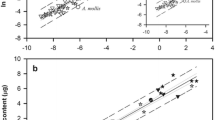Abstract
We have capitalised on the availability of eggs and adults of the naked dragonfish Gymnodraco acuticeps (Sub-order Notothenioidei, F. Bathydraconidae) near McMurdo Station, Antarctica to examine metabolic energy utilization at different stages of its life cycle. Average egg respiration rates were found to increase from 2.17±1.02 nmol O2 h−1 ind−1 at about 17 h post-fertilization (hpf) to 5.72±0.56 nmol h−1 ind−1 at about 24 hpf, during which time the eggs underwent first cleavage. The respiration rates of embryos from 2–20 days post-fertilization (dpf) averaged 4.11±1.47 nmol O2 h−1 ind−1. About 10 months post-fertilization, oxygen consumption rates of 27.14±3.92 nmol O2 h−1 ind−1 were recorded immediately prior to hatching, with a peak of 112.41±31.38 nmol O2 h−1 ind−1 at the time of hatch. Larvae aged 46–63 days post-hatch had an average respiration rate of 64.4±15.11 nmol O2 h−1 ind−1. Mass-specific respiration rates of hatched larvae (approximately 1–2 months old) were calculated using dry weights (DW) and averaged 16.1±3.4 nmol O2 h−1 mg−1 DW. Adult dragonfish respiration rates (corrected for a 100 g fish and using a 0.8 scaling exponent) averaged 0.91±0.36 mmol O2 kg−1 h−1 after a 48 h acclimatization period, which is not indicative of significant metabolic cold adaptation. The energy contents of dragonfish eggs and larvae were also measured by microbomb calorimetry and used, along with the respiration data, in an initial approach to estimate an energy budget. In order to balance the budget, the bulk of the available post-gastrulation respiratory energy (during 213 days of embryonic incubation) must be consumed at a relatively low average rate (7.1 nmol O2 h−1 ind−1), which supports the possibility that advanced dragonfish embryos overwinter in a relatively quiescent metabolic state while awaiting a suitable stimulus (such as the return of the sun) to initiate hatching.







Similar content being viewed by others
References
Calow P (1977) Conversion efficiencies in heterotrophic organisms. Biol Rev 52:385–409
Clarke A, Johnston NM (1999) Scaling of metabolic rate with body mass and temperature in teleost fish. J Animal Ecol 68:893–905
Eastman JT (2005) The nature of the diversity of Antarctic fishes. Polar Biol 28:93–107
Evans CW, Cziko P, Cheng C-HC, DeVries AL (2005) Spawning behaviour and early development in the naked dragonfish Gymnodraco acuticeps. Antarct Sci 17:319–327
Finn RN, Rønnestad I, Fyhn HJ (1995) Respiration, nitrogen and energy metabolism of developing yolk-sac larvae of Atlantic halibut (Hippoglossus hippoglossus L.) Comp Biochem Physiol 111A:647–671
Finn RN, Rønnestad I, van der Meeren T, Fyhn HJ (2002) Fuel and metabolic scaling during the early life stages of Atlantic cod Gadus morhua. Mar Ecol Prog Ser 243:217–234
Gnaiger E (1983) Calculation of energetic and biochemical equivalents of respiratory oxygen consumption. In: Gnaiger E, Forstner B (eds) Polarographic oxygen sensors. Springer, Berlin Heidelberg New York, pp 337–345
Heming TA, Buddington RK (1988) Yolk absorption in embryonic and larval fishes. In: Hoar WS, Randall DJ (eds) Fish Physiology, vol XIA. Academic, San Diego, pp 408–438
Holeton GF (1974) Metabolic cold adaptation of polar fish: fact or artefact? Phys Zool 47:137–152
Jordan AD, Jungersen M, Steffensen JF (2001) Oxygen consumption of east Siberian cod: no support for the metabolic cold adaptation theory. J Fish Biol 59:818–823
Knox G (1994) The biology of the Southern Ocean. CUP, Cambridge
Kock KH, Kellermann A (1991) Reproduction in Antarctic notothenioid fish. Antarct Sci 3:125–150
Krogh A (1914) The quantitative relation between temperature and standard metabolism in animals. Int Phys-Chem Biol 1:491–508
Krogh A (1916) The respiratory exchange of animals and man. Longmans, London
Macdonald JA, Montgomery JC, Wells RMG (1987) Comparative physiology of Antarctic fishes. Adv Mar Biol 24:3321–3388
Marsh AG, Cohen S, Epifanio CE (2001). Larval energy metabolism and physiological variability in the Asian shore crab, Hemigrapsus sanguineus. Mar Ecol Prog Ser 218:303–309
Marsh AG, Leong P, Manahan DT (1999) Energy metabolism during embryonic development and larval growth of an Antarctic sea urchin. J Exp Biol 202:2041–2050
Marsh AG, Manahan DT (1999) A method for accurate measurements of the respiration rates of marine invertebrate embryos and larvae. Mar Ecol Prog Ser 184:1–10
Mommsen TP, Walsh PJ (1988) Vitellogenesis and oocyte assembly. In: Hoar WS, Randall DJ (eds) Fish physiology, vol XIA. Academic, San Diego, pp 348–395
Needham J (1931) Chemical embryology, vol 2. Cambridge University Press, Cambridge, pp 946–986
Phillipson J (1964) A miniature bomb calorimeter for small biological samples. Oikos 15:130–139
Rombough PJ (1988) Respiratory gas exchange, aerobic metabolism, and effects of hypoxia during early life. In: Hoar WS, Randall DJ (eds) Fish physiology, vol XIA. Academic, San Diego, pp 59–161
Steffensen JF (2002) Metabolic cold adaptation of polar fish based on measurements of aerobic oxygen consumption: fact or artefact? Comp Biochem Physiol 132A:789–795
Steffensen JF, Bushnell PG, Schurmann H (1994) Oxygen consumption in four species of teleosts from Greenland: no evidence of metabolic cold adaptation. Polar Biol 14:49–54
Wells RMG (1987) Respiration of Antarctic fish from McMurdo Sound. Comp Biochem Physiol 88A:417–424
Acknowledgements
We thank Kevin Hoefling, Ben Hunt and Luke Hunt for their efforts in collecting eggs and adult fish by SCUBA at McMurdo Station, Antarctica, and Paul Ulrich and Allison Green for their assistance with some of the respiration equipment. This work was supported by: the National Science Foundation, Office of Polar Programs (#02-31006 to ALD and C-HCC; #02-38281 to AGM). CWE is grateful to the University of Auckland Research Committee for their continuing support.
Author information
Authors and Affiliations
Corresponding author
Rights and permissions
About this article
Cite this article
Evans, C.W., Pace, L., Cziko, P.A. et al. Metabolic energy utilization during development of Antarctic naked dragonfish (Gymnodraco acuticeps). Polar Biol 29, 519–525 (2006). https://doi.org/10.1007/s00300-005-0083-4
Received:
Revised:
Accepted:
Published:
Issue Date:
DOI: https://doi.org/10.1007/s00300-005-0083-4




